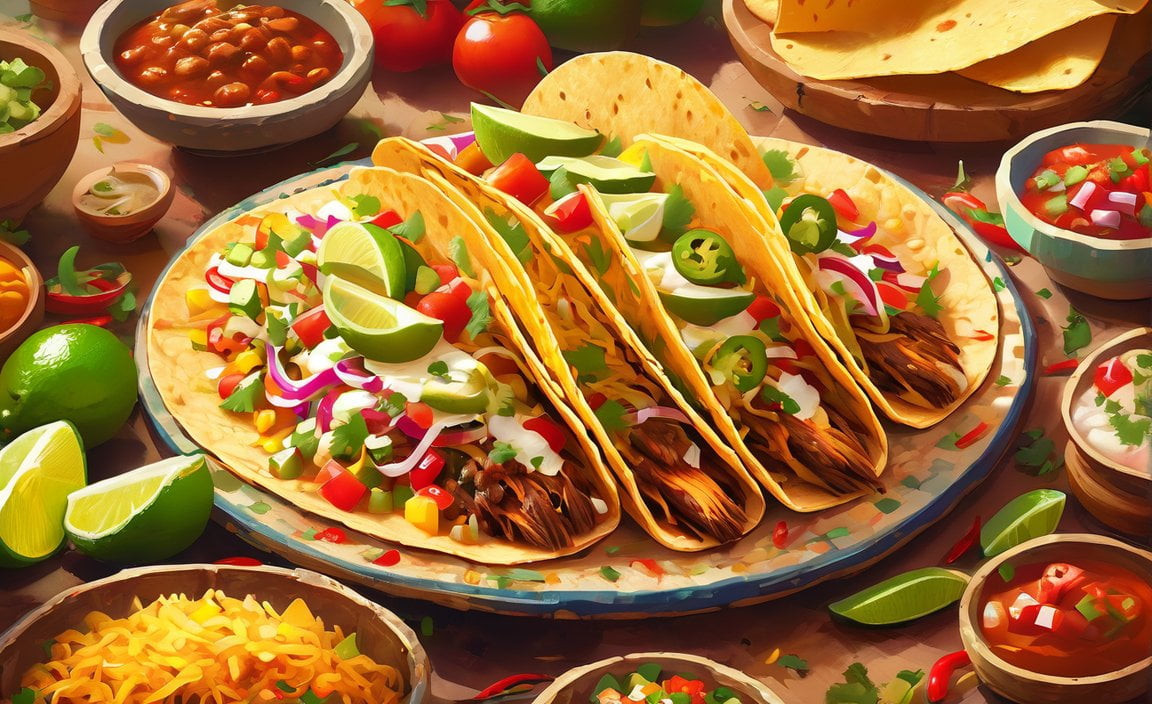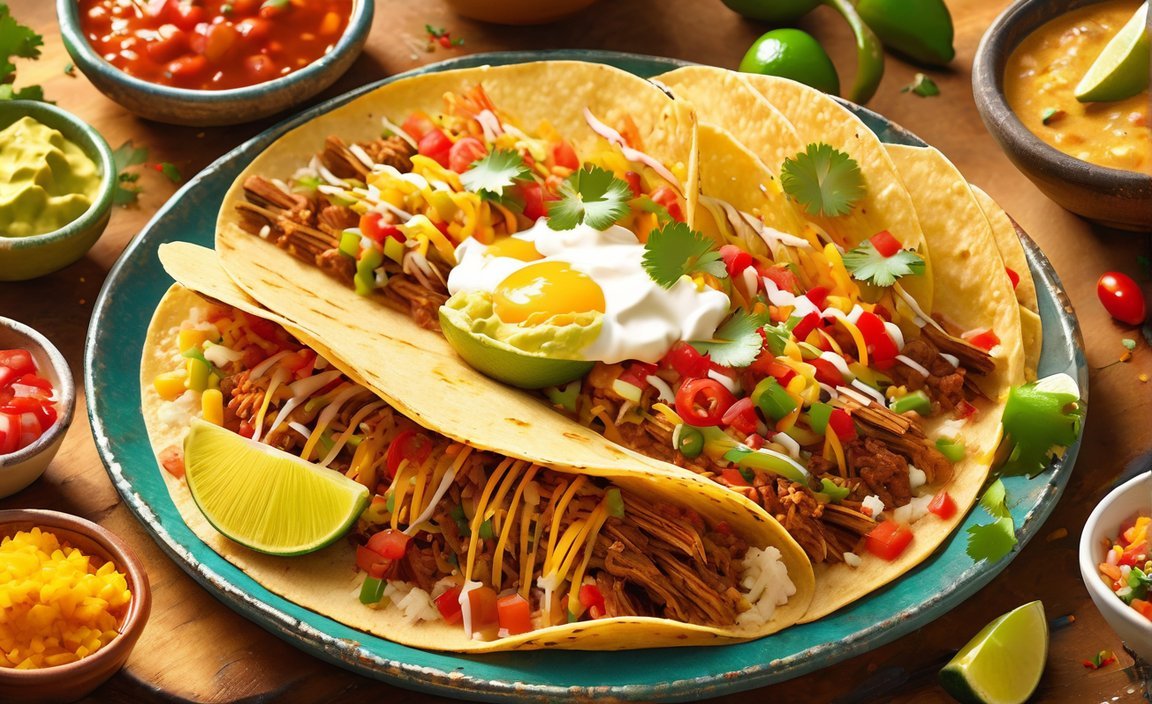Discover 10 Fascinating Facts About Mexican Food and embark on a culinary journey through the vibrant and flavorful cuisine of Mexico. As we peel back the layers of this rich culinary tradition, you’ll uncover a tapestry of diverse flavors, ancient techniques, and intriguing history. From the origins of beloved dishes to the surprising ingredients that make Mexican cuisine so distinctive, prepare to satisfy your curiosity and whet your appetite for more knowledge about this fascinating cuisine.
Key Takeaways:
– Mexico is the birthplace of tomatoes, chocolate, and avocados, which are essential in Mexican cuisine.
– Chiles en nogada is a patriotic dish that represents the colors of the Mexican flag.
– Tamales have a rich history and have been enjoyed since ancient times by the Maya and Aztecs.
– Tacos are a versatile and beloved Mexican dish, available in various fillings and suitable for any meal.
– The famous Caesar salad was actually invented in Mexico by an Italian-American chef named Caesar Cardini.
– Nachos were created by a Mexican waiter named Nacho, who quickly assembled them as a snack for customers.
– Mole is a complex and flavorful sauce made with chilies and spices, commonly served with chicken or pork.
– Traditional Mexican dishes often require special tools like a molcajete (stone mortar and pestle) or a tortilla press.
– Mexican desserts, such as the Rosca de Reyes, may contain a hidden baby figurine for good luck.
– Mexico offers a wide variety of edible insects, some of which are considered delicacies and excellent sources of protein.
10 Facts about Mexican Food

Mexican cuisine is rich in history, flavors, and unique cooking techniques. Exploring the vibrant culinary traditions of Mexico reveals a fascinating world of gastronomic delights and cultural significance. Here are 10 lesser-known facts about Mexican food that will leave you craving more from this flavorful cuisine.
1. Tomatoes, Chocolate, and Avocados: Gifts from Mexico
Did you know that some of the world’s most beloved ingredients originated in Mexico? Tomatoes, chocolate, and avocados are all gifts from Mexican cuisine. These ingredients play a crucial role in Mexican dishes, adding depth and flavor to classics like salsa, mole, and guacamole. The luscious avocado, creamy and versatile, is a beloved companion to many Mexican dishes.
2. Chiles en Nogada: A Festive Culinary Delight
Chiles en nogada, a dish that reflects the vibrant colors of the Mexican flag, is a true festive delight. Roasted poblano peppers are stuffed with a delicious mixture of meats, fruits, and spices, and then crowned with a creamy walnut sauce and a sprinkle of pomegranate seeds. This visually stunning dish is often enjoyed during Mexico’s Independence Day celebrations.
3. Tamales: Ancient Delicacies Passed Down through Generations
Tamales are one of the oldest Mexican foods, with roots tracing back to the ancient Maya and Aztec civilizations. These delectable treats are made from masa, a traditional corn dough, which is filled with various ingredients such as meats, cheese, or vegetables. Wrapped in a corn husk and steamed to perfection, tamales continue to be a beloved staple in Mexican cuisine.
4. Tacos: A Versatile and Beloved Mexican Dish
Tacos are perhaps one of the most iconic Mexican dishes, known for their incredible versatility. Whether it’s enjoying street tacos filled with succulent grilled meats topped with onions and cilantro or savoring gourmet tacos with unique and creative fillings, tacos offer a flavorsome experience for any meal of the day.
5. The Hidden Italian Roots of Caesar Salad
Did you know that the popular Caesar salad has Italian roots but was actually invented in Mexico? An Italian-American chef named Caesar Cardini created this refreshing salad in Tijuana. The classic Caesar salad combines crisp romaine lettuce, crunchy croutons, savory Parmesan cheese, and a tangy dressing made with anchovies, garlic, and Worcestershire sauce.
6. Nachos: Invented by a Mexican Waiter Named Nacho
Sometimes culinary brilliance strikes in the most unexpected moments. Nachos, the beloved snack featuring crunchy tortilla chips smothered in melted cheese and topped with jalapenos, was invented on the spot by a Mexican waiter named Ignacio “Nacho” Anaya. This impromptu creation quickly became a popular appetizer enjoyed by people around the world.
7. Mole: The Art of Complex Flavors
Mole, a beloved sauce in Mexican cuisine, is often misunderstood due to its name. Contrary to popular belief, mole is not derived from any animal but is a complex sauce made with chilies and spices. This rich and flavorful sauce, typically served over chicken or pork, is a true showcase of Mexico’s culinary artistry.
8. Traditional Tools: Essential in Mexican Cooking
Mexican cuisine often requires the use of unique tools that add authenticity and depth to the cooking process. From the molcajete, a stone mortar, and pestle used to grind spices and create flavorful salsas, to the tortilla press, which ensures perfectly thin and round tortillas, these traditional tools are essential for capturing the essence of Mexican flavors.
9. Sweet Surprises: Hidden Treasures in Mexican Desserts
Mexican desserts, known for their indulgent and vibrant flavors, often hold sweet surprises. One such surprise is the inclusion of a baby figurine in certain desserts, bringing good luck to the lucky person who finds it. This tradition is especially associated with the celebration of Dia de los Reyes (Three Kings Day) and is found in a traditional cake called Rosca de Reyes.
10. Embracing Edible Insects: A Unique Source of Protein
Mexico is home to the most edible insects in the world, and some of them are considered delicacies. Insects like chapulines (grasshoppers) and escamoles (ant eggs) are incorporated into traditional Mexican dishes and provide a unique source of protein. Embracing this age-old practice is not only sustenance but also a celebration of Mexico’s cultural heritage.
Mexican cuisine is a flavorful journey that goes beyond familiar dishes like tacos and guacamole. Exploring these 10 fascinating facts about Mexican food reveals the depth, history, and unique traditions that make this vibrant cuisine a true culinary gem. So why not dive deeper into the world of Mexican flavors and indulge in this rich cultural tapestry of delightful cuisine?
Here are two captivating sentences with active internal links:
Are you curious to learn about the fascinating world of Japanese cuisine? Dive into these 10 facts about Japanese food and discover intriguing tidbits about their unique culinary tradition. 10 facts about Japanese food
Have you ever wondered how light energy works and its importance in various fields? Unravel the mysteries with these captivating 10 facts about light energy that will leave you enlightened and inspired. 10 facts about light energy
The Vibrant Flavors of Mexican Cuisine

Mexican cuisine is renowned for its vibrant, bold flavors that come from a variety of ingredients, including chili peppers, spices, and herbs like cilantro and epazote. These ingredients have a rich history and add depth and complexity to traditional Mexican dishes. Let’s explore 10 fascinating facts about the vibrant flavors of Mexican cuisine.
Fact 1: Chili Peppers – The Spice of Life
Chili peppers are the foundation of Mexican cuisine. They come in a variety of shapes, colors, and heat levels, and are used to add both heat and flavor to dishes. From the mild poblano pepper to the fiery habanero, chili peppers contribute to the dynamic and diverse taste of Mexican food. Their vibrant flavors are a staple in traditional Mexican dishes such as salsa, mole, and enchiladas.
Fact 2: Spices – Adding Aromatic Delights
Mexican cuisine is infused with an array of spices that enhance its unique flavors. Cumin, an aromatic spice with smoky undertones, adds warmth to dishes like tacos and Mexican rice. Mexican oregano, known for its citrusy and earthy notes, is commonly used in salsa and taco seasoning. Together, these spices create a symphony of flavors that elevate Mexican cuisine to new heights.
Fact 3: Herbs – Freshness and Depth
Herbs play a crucial role in Mexican cooking, providing freshness and depth to dishes. Cilantro, with its bright and citrusy flavor, adds a refreshing touch to salsas, guacamole, and garnishes. Epazote, a lesser-known herb, imparts a distinctive taste and aroma, particularly when used in bean dishes. These herbs intertwine with other ingredients to create the complex and vibrant flavors synonymous with Mexican cuisine.
Fact 4: Chili Powder – A Perfect Combination
Chili powder is a staple spice blend in Mexican cooking. It is not just ground chili peppers but a mix of dried chiles, cumin, and oregano. This unique combination adds a rich and spicy flavor to classic Mexican dishes like enchiladas, chili con carne, and mole sauce. The depth and complexity of chili powder make it an essential ingredient in the vibrant palette of Mexican cuisine.
Fact 5: Unique Ingredients – Unraveling New Flavors
Mexican cuisine boasts a range of unique ingredients that contribute to its distinct flavor profile. Epazote, for example, is a lesser-known herb used to flavor beans and help alleviate any potential digestion issues. Its pungent aroma and subtle taste provide a one-of-a-kind experience in Mexican dishes. By incorporating these unique ingredients, Mexican cuisine offers culinary adventures that are both fascinating and unexpected.
Fact 6: The Art of Flavor Combination
To truly experience the vibrant flavors of Mexican cuisine, it is essential to embrace the art of flavor combination. Garlic, onions, and herbs like oregano and cumin work in harmony with chili peppers and unique ingredients like epazote. The marriage of these diverse flavors results in the bold, enticing taste that characterizes traditional Mexican dishes.
Key Takeaways:
- Chili peppers are the foundation of Mexican cuisine, adding both heat and flavor.
- Spices like cumin and Mexican oregano contribute warmth and complexity to dishes.
- Herbs like cilantro and epazote provide freshness and depth to Mexican cooking.
- Chili powder, a blend of dried chiles, cumin, and oregano, adds a rich and spicy flavor.
- Unique ingredients like epazote offer unexpected tastes and aromas.
- The combination of flavors, including garlic, onions, and herbs, creates a symphony of taste in Mexican cuisine.
Citations:
– Traditional Flavoring Ingredients of Mexican Cuisine – The Spruce Eats
– Exploring the Rich and Vibrant Food Culture of Mexico – LatinoTC
Mexican Street Food: A Taste Sensation
Mexican street food is renowned for its delicious and affordable options, offering a wide range of dishes such as tacos, elotes, and tamales. In this article, we will explore ten fascinating facts about Mexican street food that will leave you craving more from this vibrant and flavorful cuisine.
Fact 1: Sopes, the Perfect Antojitos
Sopes, also known as picaditas, are popular antojitos (street snacks) in Mexico. These delectable treats consist of lightly-fried, thick corn dough with a border around the edges to hold the ingredients. Usually, sopes are topped with refried beans and can be filled with shredded chicken, pork, or other meats. These savory delights are a must-try when exploring Mexican street food.
Fact 2: The Versatile Taco
Tacos reign supreme as the most popular Mexican street food dish. From soft corn tortillas to crispy shells, tacos come in a variety of styles and fillings that reflect the diverse culinary regions of Mexico. Whether filled with grilled meats, tender carnitas, or flavorful seafood, tacos are a delicious handheld delight that embodies the spirit of Mexican street food.
Fact 3: Elote, the Mouthwatering Mexican Street Corn
Elote, also known as Mexican street corn, is a beloved street food item. Grilled or boiled corn on the cob is slathered with mayonnaise, cotija cheese, chili powder, and a squeeze of lime juice. The combination of these flavors creates a delightful contrast of creamy, tangy, and spicy, making elote a true crowd-pleaser.
Fact 4: Aguas Frescas, Refreshing Fruit Drinks
Quench your thirst with aguas frescas, refreshing fruit drinks commonly sold by street vendors in Mexico. These delightful beverages are made by blending fruits, water, and sometimes sweeteners. From the creamy horchata to the tangy tamarind and floral Jamaica, aguas frescas offer a fruity and refreshing experience to accompany your street food adventures.
Fact 5: Tlayuda, Oaxaca’s Culinary Gem
Tlayuda is a culinary gem hailing from the city of Oaxaca. It consists of a large, crispy tortilla topped with refried beans, cheese, and various meats or vegetables. The combination of textures and flavors in a tlayuda creates a mouthwatering experience that truly showcases the vibrant cuisine of Mexico.
Fact 6: Gorditas, the Hearty Stuffed Tortillas
Gorditas are thick, stuffed tortillas that boast a delectable array of fillings. Whether filled with succulent meats, savory cheese, or flavorful beans, gorditas are a satisfying and customizable street food option. Topped with salsa, lettuce, and other garnishes, the flavors and textures of gorditas are sure to impress your taste buds.
Fact 7: Tamales, Ancient Delicacies
Tamales are one of the oldest Mexican foods, with a history dating back thousands of years. These steamed corn dough delights are filled with various ingredients, such as meats, cheese, or vegetables. Wrapped in corn husks, tamales can be enjoyed as a meal or a snack, offering a taste of tradition and history in every bite.
Fact 8: Pambazo, a Fiery Mexican Sandwich
Pambazo, a unique Mexican sandwich, is made with a soft white bread roll dipped in guajillo chili sauce and fried to perfection. Typically filled with potatoes, chorizo, lettuce, and other ingredients, pambazos pack a punch of flavors that will tantalize your taste buds. This fiery street food delight is not to be missed.
Key Takeaways:
- Mexican street food offers a wide range of delicious and affordable options.
- Sopes and tacos are staple street snacks that showcase the versatility and mouthwatering flavors of Mexican cuisine.
- Elote, a grilled or boiled corn on the cob, is a must-try street food item topped with mayonnaise, cheese, chili powder, and lime juice.
- Aguas frescas, refreshing fruit drinks, complement Mexican street food and quench your thirst.
- Tlayuda, gorditas, tamales, and pambazo are other delightful street food options that offer unique flavors and textures.
Sources:
1. The Best Mexican Street Foods – TripSavvy
2. The 20 Best Mexican Street Foods – Amigofoods
Mole: A Complex and Flavorful Sauce in Mexican Cuisine
Mole, a complex and flavorful sauce made with a combination of chili peppers, spices, nuts, and chocolate, is a signature element of Mexican cuisine. In this article, we will explore the origins, ingredients, and preparation of this delicious sauce. So, let’s dive into the fascinating world of mole!
The Origins of Mole Sauce
The word “mole” comes from the Nahuatl language, spoken by the Aztec Empire and the modern-day Nahua people in Mexico. It simply means “sauce” in Nahuatl. Mole sauce has a long history in Mexican cuisine, with recipes passed down through generations. It is deeply rooted in Mexican cultural traditions, often enjoyed during celebrations and special occasions.
A Symphony of Ingredients
Authentic mole sauce requires a harmonious blend of diverse ingredients. The main components include dried chilies, spices, nuts, seeds, and sometimes chocolate. Dark black chilies, such as ancho, pasilla, or mulato, are commonly used to give mole its rich color and smoky flavor. Spices like cinnamon, cumin, coriander, cloves, and black pepper add depth and complexity. Nuts and seeds, such as almonds, peanuts, pumpkin seeds, and sesame seeds, provide a creamy and nutty texture. The addition of chocolate brings a touch of sweetness to balance the spiciness of the chilies.
The Art of Mole Preparation
Making mole sauce is a labor of love. The process begins by toasting the dried chilies in a dry skillet until they become fragrant. Then, they are combined with the other ingredients, including spices, nuts, seeds, and chocolate, in a blender or food processor. This mixture is blended until smooth and creamy, with water or chicken broth added to achieve the desired consistency. The sauce is then simmered over low heat to allow the flavors to meld together.
Best Chilies for Mole Sauce
Different chilies impart unique flavors to mole sauce. The dark-colored ancho chilies offer a mild heat level and a slightly sweet and smoky flavor. Pasilla chilies, on the other hand, have a medium heat level and a rich, earthy taste. Mulato chilies contribute a deep, fruity flavor to mole sauce. Experimenting with these chilies allows you to customize the heat and flavor profile of your mole sauce according to your preference.
Storing Mole Sauce
To keep your homemade mole sauce fresh and flavorful, proper storage is important. Transfer the sauce to an airtight container and refrigerate it for up to 4 days. If you have leftover sauce or want to make a larger batch for future use, freezing is an option. Mole sauce can be stored in the freezer for up to 6 months, so you can always have it on hand whenever you crave its deliciousness.
Key Takeaways:
- Mole sauce is a traditional Mexican sauce that has been enjoyed for centuries.
- It is made with a combination of dried or fresh chilies, spices, nuts, seeds, and sometimes chocolate.
- The word “mole” comes from the Nahuatl language and means “sauce.”
- Different chilies, such as ancho, pasilla, and mulato, are used to create unique flavors in mole sauce.
- Mole sauce can be stored in the refrigerator for up to 4 days or in the freezer for up to 6 months.
Sources:
1. Mole Negro – Feasting At Home
2. How To Make Mole – Mexicali Blue
FAQ
Q1: What are some essential ingredients in Mexican cuisine?
A1: Essential ingredients in Mexican cuisine include tomatoes, chocolate, and avocados, which all originated in Mexico and are used in many traditional Mexican dishes.
Q2: Can you explain the significance of chiles en nogada in Mexican cuisine?
A2: Chiles en nogada is a festive Mexican dish that reflects the colors of the Mexican flag. It consists of roasted poblano peppers filled with a mixture of meats, fruits, and spices, topped with a creamy walnut sauce and pomegranate seeds.
Q3: What is the history of tamales in Mexican food?
A3: Tamales are one of the oldest Mexican foods, dating back to the ancient Maya and Aztecs. These savory treats are made from masa (corn dough) filled with various ingredients like meats, cheese, or vegetables, wrapped in a corn husk and steamed.
Q4: Are tacos only meant for certain meals?
A4: Tacos can be eaten for any meal, and there are many varieties of them. From street tacos filled with grilled meats and topped with onions and cilantro to gourmet tacos with unique fillings, tacos are a versatile and beloved Mexican dish.
Q5: Who invented the famous Caesar salad?
A5: Caesar salad was actually invented in Mexico by an Italian-American chef named Caesar Cardini. This popular salad combines romaine lettuce, croutons, Parmesan cheese, and a tangy dressing typically made with anchovies, garlic, and Worcestershire sauce.
- Sept 31 Myth: Unveiling Calendar Secrets - March 18, 2025
- How Long & Till December 18, 2025: Accurate Countdown Guide - March 18, 2025
- Discover Japanese Artists: A Complete History - March 18, 2025
















